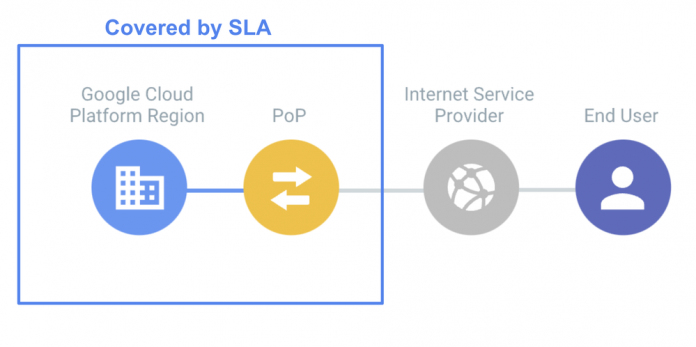Internet Data Transfer connects customer applications to their users
Customers value Google Cloud for low-latency, reliable and secure internet Data Transfer between web applications and their users, all across the globe. That connectivity is enabled by a state-of-the-art global network backbone that is peered with all major ISPs, around the world.
We offer internet Data Transfer in two flavors: Premium and Standard Tier. Premium Tier is the default networking choice, and provides global routing within Google’s network backbone, for strong security, performance and reliability. Standard Tier relies heavily on the public internet. VMs operating on Premium Tier have a 99.99% availability SLA (~4 mins/month downtime), and latency is generally better than Standard Tier. Additionally, traffic traveling within Google’s backbone is protected from threats in the public internet.
On the other hand, Standard Tier is a cost-effective solution for customers who care about optimizing workloads locally within a region. It’s a great option for reducing a customer’s total cost of ownership (TCO) while still offering key networking services. To further enhance its value proposition, we launched several exciting updates to Standard Tier in 2023:
L4 / L7 Regional Load Balancing with GKECloud NAT Support200GB/month free tier for all customers
Introducing 99.9% availability SLA for Standard Tier
Network reliability is a critical consideration for customers who want to ensure a consistently high-quality application experience for users. We are excited to now offer a three-nines (99.9%) availability SLA for Standard Tier internet Data Transfer. This complements Premium Tier’s existing four-nines (99.99%) availability SLA.
How is the 99.9% availability SLA defined?
With the Standard Tier availability SLA, a customer should experience at least 99.9% of “good minutes” within a month, where a “bad minute” refers to a loss of external connectivity to the VM (i.e., 100% packet loss). This translates to a cap of ~43 bad minutes per month. If we miss this commitment, we are liable to financial credits as dictated in the SLA documentation.
What does the SLA cover?
This SLA covers traffic within Google’s network i.e., from a VM to Google’s network edge, as shown in the diagram below. After the packet leaves Google’s network, it is no longer covered by the SLA, as the service is dependent on third-party ISPs.
Standard Tier is designed to resist failures
We are confident in the resiliency of Standard Tier because it is designed with redundancy and failure protection in mind. While Standard Tier packets always default to egressing from Google’s nearest edge Point of Presence (PoP), we protect against a single point of failure. We do so by peering redundant transit providers in case one fails, and maintaining redundant links to each provider.
In the worst-case scenario, even if the entire edge metro near your workload were to fail, the packets would fail over to Premium Tier and egress via another nearby metro. The workload’s availability would not be impacted.
Standard Tier also helps ensure that incoming packets reach their destination, even if one path fails. For packets that enter into a Google Cloud region, we announce specific prefixes to local transit providers so incoming traffic passes into them by default. However, if both transit providers were to fail, then traffic would re-route to more general summary routes that we announce globally. These allow packets to ingress from another edge metro and reach their destination over Google’s network backbone.
Learn more
Standard Tier Data Transfer is a great option for cost-sensitive customers. Click here to learn more about it, or choose it as an option when you create your next project, VM instance, or Regional Load Balancer in the Google Cloud console.
Cloud BlogRead More


